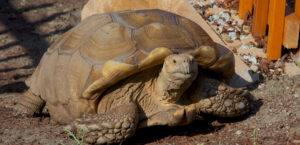Curious about the remarkable lives of Sulcata tortoises? These majestic creatures hold a special place in the animal kingdom, boasting impressive longevity that leaves many in awe. So, how long do these fascinating tortoises actually live?
Sulcata tortoises, also known as African spurred tortoises, are renowned for their impressive lifespan. In the wild, they typically live for around 70 to 100 years. However, with proper care and habitat, these magnificent creatures can even surpass the century mark, living up to 150 years or more in captivity.
Their longevity serves as a testament to their resilience and the importance of providing them with the right environment and care throughout their lives.
Basic Characteristics of Sulcata Tortoises

Sulcata tortoises, also known as African spurred tortoises, possess several distinctive characteristics:
- Large Size: Sulcata tortoises are one of the largest tortoise species in the world, with adults reaching lengths of over 30 inches (76 cm) and weights of up to 100 pounds (45 kg) or more.
- Highly Domed Shell: They have a prominent, domed shell that is typically light tan or yellowish-brown in color. The shell, or carapace, is covered in thick, bony plates called scutes.
- Spurred Margins: The shell of Sulcata tortoises has raised, serrated edges, giving them their characteristic “spurred” appearance. These serrations become less pronounced as the tortoise ages.
- Long Lifespan: Sulcata tortoises are known for their longevity, with lifespans ranging from 50 to over 100 years in captivity, and potentially even longer in the wild under optimal conditions.
- Herbivorous Diet: They are strict herbivores, primarily feeding on grasses, hay, and various leafy greens. A high-fiber, low-protein diet is essential for their health and proper digestion.
- Adaptation to Arid Environments: Sulcata tortoises are native to the arid regions of sub-Saharan Africa, where they have adapted to tolerate high temperatures and limited water availability. They are adept at conserving moisture and can survive for long periods without drinking water.
- Burrowing Behavior: In the wild, Sulcata tortoises are known to dig burrows to escape extreme temperatures and regulate their body temperature. This behavior helps them avoid heat stress and dehydration.
- Social Animals: While not strictly social creatures, Sulcata tortoises can be found in small groups in their natural habitat. However, they may exhibit territorial behavior, especially during mating season.
- Maturity and Reproduction: Sulcata tortoises reach sexual maturity between 15 to 20 years of age. Mating typically occurs during the rainy season, and females lay clutches of eggs in shallow nests dug in the soil.
- Protected Status: Due to habitat loss, poaching, and the pet trade, Sulcata tortoises are listed as a vulnerable species by the International Union for Conservation of Nature (IUCN). It’s essential to ensure that captive specimens are acquired legally and responsibly to prevent further decline in wild populations.
Understanding these basic characteristics can help ensure proper care and husbandry for Sulcata tortoises in captivity while also appreciating their natural adaptations and behaviors in the wild.
Lifespan of Sulcata Tortoises
Sulcata tortoises, scientifically known as Centrochelys sulcata, are renowned for their impressively long lifespans. In the wild, they can live for several decades, typically ranging from 50 to 70 years. However, with proper care and a suitable environment, they have been known to live well beyond that.
In captivity, where they are shielded from predators and provided with consistent access to food, water, and veterinary care, Sulcata tortoises can thrive and potentially live even longer. Some individuals have been documented to exceed 100 years of age in captivity.
Several factors contribute to their longevity:
- Habitat: Providing a spacious and suitable habitat with plenty of room for exercise and natural behaviors is crucial. Sulcata tortoises are native to the Sahel region of Africa, where they inhabit dry grasslands and savannas.
- Diet: A well-balanced diet is essential for their health and longevity. They are primarily herbivores, consuming a variety of grasses, weeds, and leafy greens. Ensuring they have access to a diverse range of vegetation rich in fiber and essential nutrients is vital.
- Environmental Conditions: Maintaining appropriate environmental conditions, including temperature, humidity, and lighting, is essential. Sulcata tortoises require warm temperatures and access to sunlight for basking to maintain their health.
- Veterinary Care: Regular veterinary check-ups and prompt treatment of any health issues are essential for maximizing their lifespan. This includes monitoring for signs of respiratory infections, shell injuries, parasites, and other common health problems.
- Social Interaction: While not as social as some other species, providing appropriate social interaction and enrichment can contribute to their overall well-being and potentially extend their lifespan.
By ensuring these factors are adequately addressed, Sulcata tortoises can live long and healthy lives, becoming cherished companions for their human caretakers for several decades or more.
Lifespan of Sulcata Tortoises in the Wild

Sulcata tortoises, also known as African spurred tortoises, have a considerable lifespan in the wild. These tortoises are known for their longevity, often living several decades. In their natural habitat, Sulcata tortoises can live anywhere from 50 to 150 years, with some reports suggesting they may even exceed 200 years under optimal conditions.
Their long lifespan can be attributed to various factors. Firstly, they have adapted to survive in arid regions of Africa, where they can endure harsh conditions such as extreme temperatures and limited food and water resources. This adaptation allows them to withstand environmental challenges that might threaten shorter-lived species.
Additionally, Sulcata tortoises have relatively few natural predators once they reach maturity, which further contributes to their longevity. However, they face threats from habitat loss, poaching, and other human activities, which can impact their population numbers and overall lifespan in the wild.
Overall, the lifespan of Sulcata tortoises in the wild is influenced by a combination of factors including their ability to adapt to their environment, limited predation as adults, and human-induced pressures on their populations.

